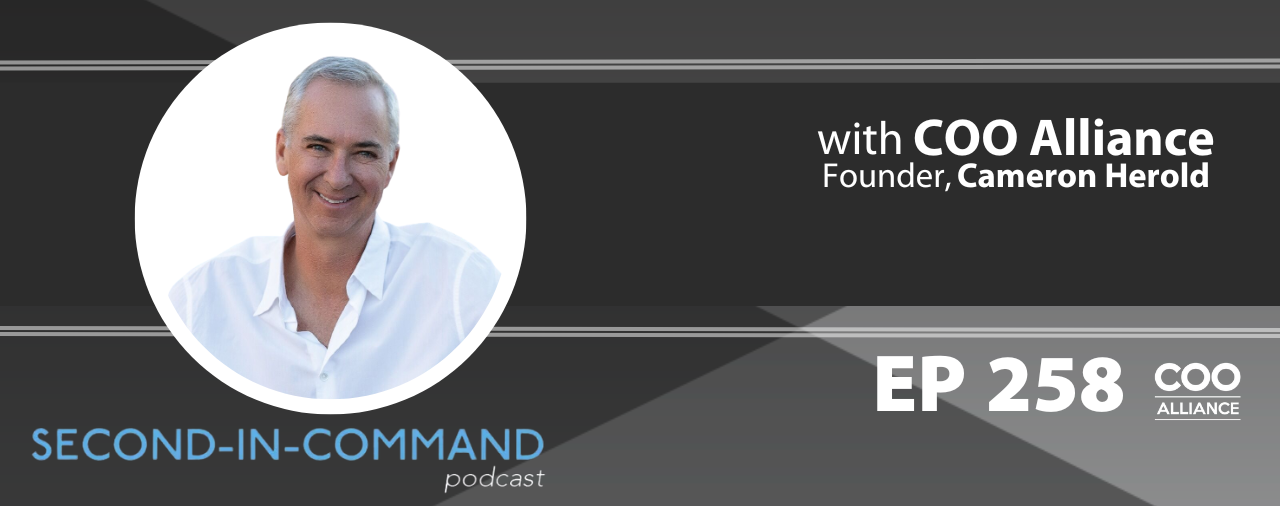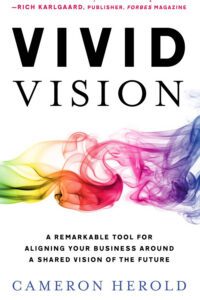In today’s episode, Cameron offers the real secrets to creating a fast-growing company.
You’ll learn how Cameron grew 1-800-Got-Junk from $2 million to $106 million in just six and a half years. You’ll discover secrets on how to build a true leadership team that will help you grow the company. Cameron will discuss methods for building a real company culture. He’ll also offer some thoughts on leveraging free PR and magnetizing a vivid vision!
In This Episode You’ll Discover:
- How to build a fast-growing company without giving away the farm.
- Why building your business is like putting together a jigsaw puzzle.
- The elements that stood out in the culture at 1-800-Got-Junk.
- How Cameron took a decidedly unsexy business and turned it into a cult, landing over 5200 media impressions.
Resources:
Connect with Cameron: Website | LinkedIn
Get Cameron’s latest book “Second in Command: Unleash the Power of your COO”
Subscribe to our YouTube channel – Second in Command Podcast on YouTube
Get Cameron’s online course – Invest In Your Leaders
—
Really quick, before we jump into the episode, you need to know about two important ways that we can help you and your company grow. Number one, check out the COO Alliance. It’s for COOs, Presidents, VP Ops, or whoever’s your company’s second in command to the CEO. The COO Alliance is the world’s leading community for the second in command and it gives COOs the tools and connections to grow themselves and the company. Head over to COOAlliance.com to learn more about our members and the results the program and our 10X Guarantee. If you qualify for membership, you can set up a complimentary call with our team to discuss if it’s right for you. I’ll tell you about number two in a bit, but first, let’s start this episode.
—
Frustrated? Trying to figure out how to grow faster? Do you want to know the real secrets to a fast-growing company? In this episode, you’re going to learn my secrets. Secrets on how I grew 1-800-GOT-JUNK? from $2 million to $106 million in six and a half years. Secrets on how to build out a true leadership team will really help you grow the company. I’ll talk about how to build a real company culture. We’re even going to cover how to leverage free PR and magnetize a vivid vision. You’re going to love this episode.
—
As an entrepreneur, you don’t know how it’s going to happen, but you can describe what it feels like. You can describe the future state. You can describe what your Zoom meetings are like or what it feels like walking through your office or your interactions with the team and the pulse and the dashboards. You end up with this description as if you were walking around your company three years from now.
It’s almost as if you hop into a time machine and travel out to December 31st, 2025, and you walk around your company and then write down everything you see. You come back to now and hand it to your team and go, “This is what it looks like. I don’t know how to do it,” but they can take every sentence and come up with 1 or 2 projects to make each sentence come true.
You ended up with a huge list of projects and you put them in order. Much like building a home, you build a foundation. You put in the plumbing and the walls. Most entrepreneurs want to put the wolf stove in the subway or the sub-zero fridge and the cabinets on day one. You got to build the foundation and put in the electrical and the plumbing. In your business, you’ve got to build the foundational parts of your business first. I think a lot of entrepreneurs get a little off the rails working on all the fancy stuff when they haven’t nailed the foundational parts of their business.
You’ve spoken on all continents. What do you typically speak about other than vivid vision? Please give us an idea of what else you cover.
I have. I think 4 or 5 core topics. The first one I call the leadership at 100 miles an hour and it’s how to build fast-growing companies. When we built 1-800-GOT-JUNK?, we had six consecutive years of 100% revenue growth. We went from $2 million to $106 million in six years. We had no debt, we had no bank facilities or bank loans, we gave up no equity in the company, and we ranked as the number two company in all of Canada to work for. I took them from 14 employees to 3,100 employees in 6 years.
I talk about how to build a great company with really good growth without giving away the farm. The second thing I talk about is building a world-class company culture. I’ve coached two companies that went on to rank number one in Australia. I coached the number two company on Glassdoor in the US, number 12 on Glassdoor in the US, number 1 in Florida, and number 1 in Ohio. I built the number two company in Canada.
I talk about culture and it’s not about the free perks. Culture’s not about the massages and the free lunch. It’s all based on the foundational things. It’s how to build that company culture even when you’re a five-person company or just starting out. The third one is around PR, which is we landed 5,200 stories about our company, including being on Oprah. It’s how to generate real press coverage, and then the fourth is the leadership lessons to my younger self.
That’s amazing. Let’s go deeper into this. I’m curious about culture and I’m curious about PR. Are you guys interested in learning more about that? Let’s go a little bit on culture because culture is such an interesting topic right now in the post-pandemic world when so many companies have seen people work remotely. What are some of the key things you think entrepreneurs need to keep in mind?
Has anybody here ever done a jigsaw puzzle? Okay, all of you. Who’s not done a jigsaw puzzle? Get out of the audience. Really? You’ve never done a jigsaw puzzle. You’re Gen Y or Gen Z. All those little tiny pieces you put together like 5,000 pieces and they become a picture. Gen Z has never done jigsaw puzzles. They’re doing Minecraft or something, whatever.
The most important thing with the jigsaw puzzle is the picture on the front of the box. Imagine if I gave you a box with 5,000 pieces and they were all red. It would take you forever to build that puzzle. The vivid vision is the picture on the front of the box. Culture starts with knowing that vision with all of your employees, your customers, and your shareholders.
Only recruiting employees that are excited about the vivid vision, pushing potential employees away that don’t like the future of what you’re building. That’s where it starts. The four corners of your jigsaw puzzle, the four corners of your business, are your core values, BHAG, core purpose and the one-year plan to make your vivid vision come true. Three-year plans are way too far out. Everything changes.
The core values have to be so deeply ingrained in your organization that you’re willing to fire people if they break them. You should only have a maximum of 4 or 5 core values. They should never be a single word. They should be a very short phrase that’s easy to understand, needs no explanation and no other bullet points. The only time I’ve ever allowed a single word to be a core value is one of my clients used the word simplify and I’m like, “That’s perfect.”
Core purpose. Simon Sinek, who popularized the whole Start with WHY. Simon was on our board of advisors four years before his first TED Talk. Simon has slept on my couch. I knew Simon when he was broke. We’ve been close friends forever. Simon helped me understand my core purpose, which is to help entrepreneurs make their dreams happen. Everything I do helps entrepreneurs. My COO Alliance, my Second In Command show, my books, it’s all helping entrepreneurs make their dreams happen.
If this was a government audience, I would’ve said no to being here because it’s not following what my core purpose is. You have to know your core purpose as your second corner. The third is your BHAG. What’s that? Jim Collins’ big, hairy, audacious goal. It’s never measurable. It’s not a million somethings or a billion whatever. By definition, the BHAG is a 20 or 30-year stretch that aligns the organization that from the inside seems possible and from the outside seems impossible.

Company Company Culture: The BHAG is a 20 or 30-year stretch that aligns the organization that from the inside seems possible and from the outside seems impossible. Page 3
An example of a BHAG, in 1972, Nike’s BHAG was to crush Adidas. That was crazy. In the “50s, Boeing’s BHAG was to democratize air travel. Google’s in 1997 was to organize the world’s information. It’s not a measurable march, but it’s something you’re always pushing towards. My BHAG is to replace vision statements with vivid visions worldwide. It’s like a 20-year, 30-year march. That’s your third corner. The fourth is the one-year plan to make it come true. Culture is when everything is really emerging from there.
The sides of your jigsaw puzzle, the first side is when culture really hits the road. That’s your people systems and that’s your recruiting, interviewing, hiring, onboarding, training, and the leadership development of people. It’s getting rid of the wrong people and having those really tight systems in your organization. Culture comes out of that. Notice it’s not the perks. It has nothing to do with free lunches or massages or whether they get free healthcare.
It’s so true. It’s never about the perks. When you took 1-800-GOT-JUNK? and made it one of the best companies to work for, was there anything that stood out about the culture?

Company Culture: Secondly, we had to build something a little bit more than a business and a little bit less than a religion. We had to get in the zone of a cult so that we could attract people and attract customers and attract press.
Yes, and I want to speak to that and I also want to speak to something that you do well at Mindvalley. I just met Dragana and you hired her at a cocktail party because her boyfriend Alex was starting to work with Mindvalley. He noticed a cultural DNA in this person where she felt like the right culture and he’s like, “What do you do? What are you good at?” Get the right people on the bus, and then we’ll find a role for you. That’s where culture really starts. It’s from identifying that.
In the early days of 1-800-GOT-JUNK?, when I got there, Brian had a very clear vision of what he wanted the business to look like. Brian was at that same lunch that I was at two and a half years before because we were in a forum group in EO. We both invested in being a part of a mastermind community called the Entrepreneurs Organization. We were actually in the same forum group that met every single month for four years.
Brian was my best man at my wedding two months before I joined him as his COO. We had an unfair advantage. We already knew each other and trusted each other, but the one thing he had was a really strong vision. The second thing was he gave a crap about people. Not their birthdays and what their dog’s name was. He actually freaking cared about them as a human.
When they were struggling or what was happening at home, he spent an inordinate amount of time out for coffee and having lunch with people, giving a crap about them. I noticed that. Those were probably the two kinds of kernels of culture. When I came in, I said we had to do three things. The first was we had to raise our prices by 50% because no one was making money. He thought I was crazy, but I’m like, “We’re not making money. You’re not making money. The guys in the trucks aren’t making money. We’re raising our prices by 50%. We will be the FedEx or the Starbucks of junk removal.”
Secondly, we had to build something a little bit more than a business and a little bit less than a religion. We had to get in the zone of a cult so that we could attract people and attract customers and attract the press. The third flywheel was we were going to generate as much free publicity, free PR as we could because we had no marketing budget whatsoever. Those were the three flywheels for us.

Company Culture: Build something a little bit more than a business and a little bit less than a religion. Getting in the zone of a cult can attract customers and the press.
That’s crazy. How would you take a company that’s basically a garbage-hauling company? 1-800-GOT-JUNK? It’s a company that you call when you have large pieces of junk that you need to be hauled away. You disassemble some furniture stuff. How do you take something like that?
It’s not sexy.
How do you turn it into a cult and then get 5,208 media impressions?
They were individual unique stories. There was no online. You couldn’t do a press wire and get 72 stories. These were individual unique stories, including Oprah, the physical print edition in The New York Times, print edition of The Wall Street Journal, print edition of Forbes.
How did you turn something so unsexy to a cult brand?
It’s the people. It’s really focusing on bringing great people in and sharing the vision. We wrote the vivid vision. Brian called it a painted picture at the time. The idea was to polarize. When you read it, 50% of the people were like, “There’s no way I would work there.” Good, go work for the government. The other 50% of the people were like, “I want in.” Great. Come on and we’ll interview you.
What caused that? It’s junk hauling. How was that polarizing?
One by one. It’s one person at a time. Christopher Bennett was an early iconic hire. Jesse Korzan was an early iconic hire. We had two employees before we hit the $4 million mark that had permanent logos tattooed on their body of our brand. 1-800-GOT-JUNK? One was on his shoulder. One was on his hip.
When you create a cult, it’s one person at a time. Has anyone ever watched the TV show The Vow about NXIVM, the sex cult? Have you seen that? I’m actually on their podcast. I’m friends with Sarah Edmondson. It was 17,000 members of this massive leadership and sex cult. Keith Raniere went to prison for it. I’m on their podcast called A Little Bit Culty, talking about when a company culture can go too far. We didn’t go too far, but we understood the DNA. We understood how to make cultures. It’s what I’m known for, but it’s one person at a time.
That’s crazy. I can imagine someone googling the sexy mind value.
I did it with house painting.
1-800-GOT-JUNK?
We did it with house painting. College Pro Painters went on to become the largest house painting company on the planet.
What was that mission pulling these people forward?
One was to build a globally admired brand. That was our BHAG. The other one was our core values, so tightly ingrained that people actually understood them and gave a shit. Another one was one person at a time, we would bring in these kinds of cult-like people with good energy regardless of if they were in IT or marketing or a payroll clerk. They had that special something and people wanted to be around that special something, and then one by one, we pushed people out who didn’t fit. We got rid of the toxic, the cultural cancers and the underperformers because government’s always hiring anyway. They can work there.
How did you foster, nurture and grow that culture?
One is by really caring. You mentioned the secret earlier. As an example, when we were about 150 at our head office and about 200 franchisees, we had every single employee in all of our franchisees watch The Secret. We had our top franchisees watch The Secret a second time with us on a cruise. We brought John Demartini and John Assaraf in to actually speak at our company. We understood quantum physics and quantum mechanics and how to stir the cult and we just kept stirring it.
I’m so happy you said that because when I was talking about that Law of Attraction, I saw you in the front row, you gave me a quizzical look, and I thought, “Cameron is thinking I was way too fluffy. He’s probably losing respect for me because I’m going off signs.”
No. Who here knows the name John Assaraf, the vision boards? This is a really funny story. I had now just left 1-800-GOT-JUNK? We’re really deep into the whole quantum mechanic stuff. I come back a week after leaving the company to get them to look at and to help out with my laptop. I get there and Brian goes, “By the way, John Assaraf from The Secrets here today. Do you want to watch him speak?”
They bring him in to speak to 240 of our head office employees. I’m like, “Sure.” I sit and watch him speak. I’m like, “I love this guy. He’s great. I’m going to go up and say hi.” I walked up to John and I said, “John, I’m Cameron Herold.” He goes, “Cameron,” and he reaches into his pocket and he pulls out the corner of an envelope.
You can fact-check this. Drop him a note. He rips off the corner of an envelope, and it’s got my name Cameron and my cell number. He goes, “Is this you?” I said, “Yes.” He goes, “I don’t know why I was given this number, but a guy, Jason Abernathy, in Washington, DC, told me to look you up when I’m in Vancouver. I was going to call you later. Can we get together for breakfast?”
I said, “Brian just told me that you and I and somebody who works with you at OneCoach are going to go for lunch later.” He goes, “No. I want one-on-one time with you.” That’s how I met John Assaraf. You have to follow this stuff. That has nothing to do with any question. It was just a random ADD moment.
That’s crazy. That’s really cool.
Important Links
- Start with WHY
- A Little Bit Culty – Episode with Cameron Herold






